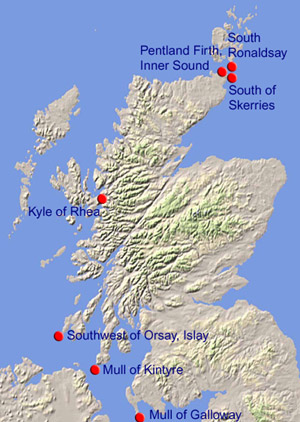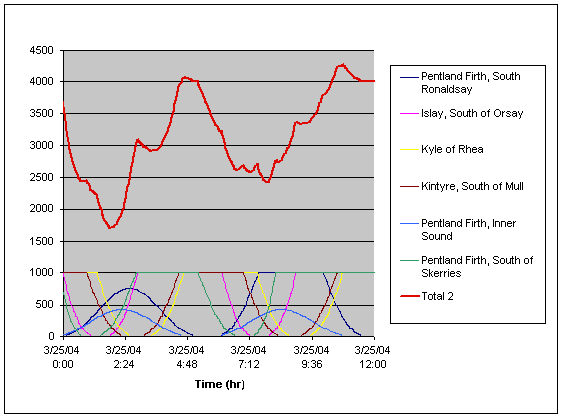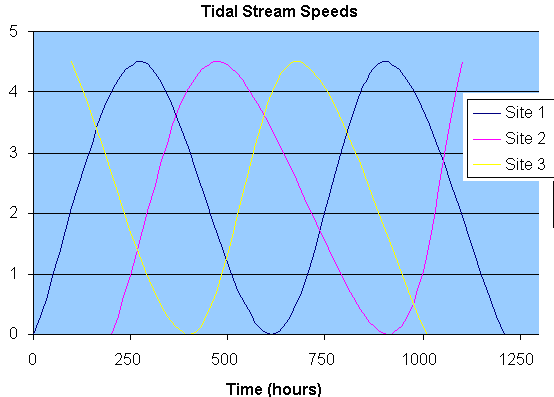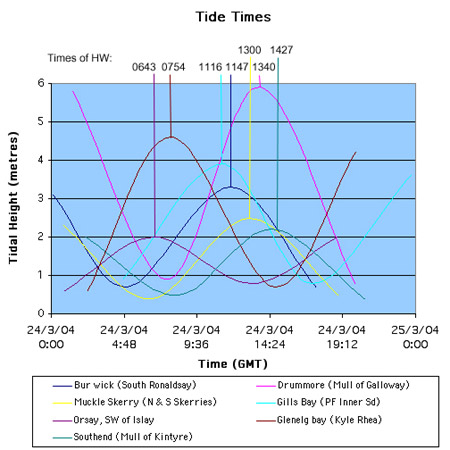


| Site Selection |
Factors Tidal Speeds Geographical Position Size Errors
Factors
Four factors were considered when selecting the sites to combine into a supply strategy:
- Tidal speeds
- Geographical position
- Size
- Errors introduced
Seven sites were selected:
- Pentland Firth, South of Skerries
- Pentland Firth, South of South Ronaldsay
- Pentland Firth, Inner Sound
- West Scotland, Kyle of Rhea
- West Scotland, Southwest of Orsay, Islay
- Kintyre, South of Mull
- Galloway, South of Mull

Figure: Selected Sites

Figure: Phased output from single 1000kW MCT Units installed at the sites selected
back to top
Tidal Speeds
Where possible, locations were selected with mean peak tidal speeds that are greater than the rated speed required, so that the turbines operating potential is maximised. The basecase 1MW turbine selected for the project required a rated speed of 2.4 metres per second.
back to top
Geographical position
The sites position determines the time of HW and LW and in turn when the peak speeds occur (the times of HW and LW change with longitude). To ensure power can always be generated so a baseload can be supplied, the peak speeds of the sites selected must be evenly distributed across the 12.4-hour cycle (as shown in the figure below).

Figure: Ideal distribution of tidal stream speed from multiple sites
Achieving such a perfect distribution of sites (and speeds) was more difficult in practice due to the geographical spread of the locations around Scotland, which experience the speeds required. The times of HW and LW for the selected sites displayed in the figure below shows the distribution. The sites at the Kyle of Rhea and the Pentland Firth, Inner Sound are very important sites as the largest gap occurs between the times of HW at these sites.

Figure: Tide times for multiple sites
back to top
Size
The size of the site i.e. the available area that was considered available to install the MCT units (taking into account the constraints detailed in the Site Analysis section of the project) was also very important when selecting the sites, as this determined the potential capacity of the site and the size of the baseload that could be supplied.
For example, selecting 3 large sites and 1 small site, would limit the overall output to the available capacity that could be installed at the small site. Alternatively, this combination may produce a shortfall in overall output when the small site is generating maximum the power and the other sites are not, and therefore increase the required amount of electricity to be generated from storage.
back to top
Errors
Errors reduced when selecting the sites where possible. Due to the errors introduced by the assumptions made when selecting the site area – described in the Site Analysis section, areas immediately adjacent to each other were not selected. For example, South of South Ronaldsay and North of the Skerries in the Pentland Firth.
back to top